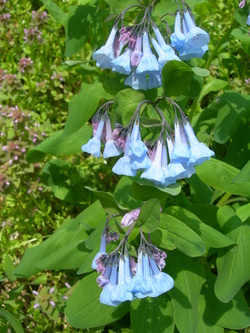Virginia Bluebells Mertensia virginica

Height: 1 to 2'
Bloom Color: Blue
Bloom Time: April
Native Status: Native throughout the eastern half of the US, north of Florida, and Ontario and Quebec.
Virginia bluebells are found in moist, rich woods and river valleys. These erect, clump-forming perennials display terminal clusters of pink buds, that expand into pendulous one-inch trumpets. The flowers are pastel blue, or occasionally, white or pink. The smooth oval leaves are slightly blue green.
Like other spring ephemerals such as trillium, spring beauty, bloodroot and Dutchman's breeches, Virginia bluebells must grow, blossom and set seed quickly during the brief interval, after cold temperatures, before trees form
enough leaves to shade them out. By mid-summer the plants have faded away.
Virginia bluebells are pollinated by bumblebees and other long-tongued bees. Hummingbirds, sphinx moths, bee flies, butterflies and skippers also feed on the nectar.
Eighteenth-century gardeners knew Virginia bluebells as "Jefferson's blue funnel flowers" after the specimens grown at Monticello. They do well in garden soil with moderate moisture, in partial to full shade. Since they die back in summer, fill in the gaps with ferns or other summer plants. Most native plant nurseries sell Mertensia virginica. Virginia bluebells can be grown from seed, but dried seeds require cold treatment.
Bloom Color: Blue
Bloom Time: April
Native Status: Native throughout the eastern half of the US, north of Florida, and Ontario and Quebec.
Virginia bluebells are found in moist, rich woods and river valleys. These erect, clump-forming perennials display terminal clusters of pink buds, that expand into pendulous one-inch trumpets. The flowers are pastel blue, or occasionally, white or pink. The smooth oval leaves are slightly blue green.
Like other spring ephemerals such as trillium, spring beauty, bloodroot and Dutchman's breeches, Virginia bluebells must grow, blossom and set seed quickly during the brief interval, after cold temperatures, before trees form
enough leaves to shade them out. By mid-summer the plants have faded away.
Virginia bluebells are pollinated by bumblebees and other long-tongued bees. Hummingbirds, sphinx moths, bee flies, butterflies and skippers also feed on the nectar.
Eighteenth-century gardeners knew Virginia bluebells as "Jefferson's blue funnel flowers" after the specimens grown at Monticello. They do well in garden soil with moderate moisture, in partial to full shade. Since they die back in summer, fill in the gaps with ferns or other summer plants. Most native plant nurseries sell Mertensia virginica. Virginia bluebells can be grown from seed, but dried seeds require cold treatment.